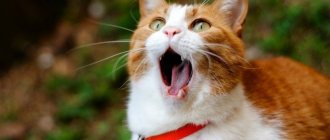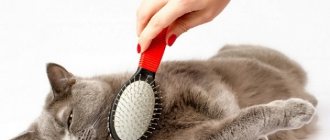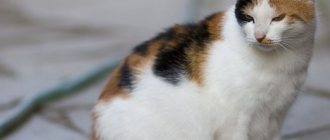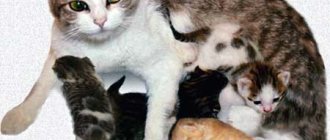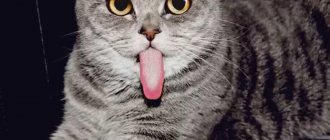Anyone who has interacted with a friendly cat or examined a cat's tongue up close knows that it is unique in many ways. The cat's tongue is truly unusual, it is long, flexible and has a very rough surface. In addition, it is also a multi-functional tool. Scientists studying a cat's tongue under a microscope have only recently discovered just how amazing it is in terms of its anatomy and abilities.
The structure of a cat's tongue
Have you ever watched a slow motion video of a cat drinking water? Its tongue acts like a tiny ball that draws water from the bowl and pushes it in a column directly into the animal's mouth. The jaws tighten around the thick water and she swallows. This all happens too quickly for the human eye to see the process in real time, but looking at the slow motion video, you'd think this technique seems to defy gravity!
There is something in common between cat and human tongues: they are both composed of transverse and longitudinal muscles. They provide mobility to this organ, which can move in different directions. A special arrangement of muscles helps these animals fold their tongue like a ladle.
Muscle tissue is covered with mucous membrane. On the outer shell there is a layer of keratin, which performs a protective function. Beneath it are capillaries that supply the organ with blood. Receptors on the surface allow you to detect bitter, sour and salty. However, cats do not distinguish sweet taste, since scientists have not found the corresponding formations in them.
The papillae on the surface of the tongue, similar in appearance to denticles, are opaque, covered with keratin, and protrude from expanded bases covering the tongue. The teeth are longer in the center and gradually become shorter on the sides and front.
Cat tongue close up
Language and symptoms
- A red or bluish tint to the tongue, gums, lips and skin may indicate blood disorders.
- Worsening or difficulty breathing
- Coloration of paw pads bluish or reddish.
When your cat develops cyanosis and you, not knowing what to do, are looking for advice on this topic on the Internet on forums, we recommend not to self-medicate or experiment on your beloved cat. The fact is that there are many reasons for cyanosis in an animal, and the consequences of your experiment may disappoint you and your family.
Although cats are speechless, a pet's language can tell a lot about her health. For example, a cat’s white tongue, covered with plaque, indicates problems with the gastrointestinal tract, intoxication, fever, and constipation. If the tongue itself turns pale, shock, anemia, vascular disorders, heart disease, and hypothermia are suspected. Yellow plaque - check the kidneys and liver. Grayish, brownish - lungs, intestines, stomach.
We invite you to familiarize yourself with: Technology of raising rabbits, broiler raising
An ulcer on a cat's tongue can form as a result of trauma - biting, stabbing with a twig, or scratching with a claw. Usually, when you can look into the mouth, the damage is easy to notice. In this case, it is enough to treat the wound with an antiseptic and ensure that the sore heals quickly. No improvement within two to three days - see a doctor. If there are several ulcers, stomatitis, a bacterial or viral infection is suspected - a reason for an immediate visit to the clinic.
Viruses, severe pain or fever are suspected if the cat is breathing heavily with its tongue hanging out. In this situation, it is important to carefully examine and feel your pet, measure its body temperature and, of course, consult a doctor immediately.
If your cat has spots, strange grooves, or pimples on his tongue, be sure to show your pet to the veterinarian. There are many reasons for changes in the color and structure of the surface of the tongue, from fungi and bacteria to all kinds of viruses and chronic diseases of internal organs. Without treatment, necrosis of a cat's tongue may begin - tissue necrosis at the cellular level, an irreversible process. In this case, part, or even all, of the language will be removed. And you will be very lucky if the tissue of the oral cavity is not involved in the process.
A black tongue in a cat may be a symptom of an acute deficiency of vitamin PP. Although more often the pet simply licked something colorful - a fur collar of a jacket, a belt, etc. Sometimes a cat gets dirty with something, and then, while licking itself, scares the owners with a tongue of an unnatural color: particles of the substance, licked from the fur coat, get stuck between the papillae, turning the pinkish tongue into black, blue, green or bright red. The latter, that is, a red tongue, may be the beginning of an inflammatory process or a sign of high blood pressure.
If the owner notices that a cat has been bitten on the tongue by a wasp - this usually happens when the pet gnaws out a caught wasp stuck between its fingers - action must be taken immediately. The tongue has many nerves and blood vessels. Poison that gets into tissue spreads quickly. If an allergic reaction (swelling) begins, the pet may die.
We suggest you read: Common allergy medications for cats How to treat allergies in a cat
To be on the safe side, you should give an intramuscular injection of diphenhydramine (or suprastin, but diphenhydramine is preferable). Dosage – 0.5 for a medium cat, 1 ml for a large pet weighing more than eight kilograms. Now all that remains is to observe your pet: if swelling still becomes noticeable, consult a doctor immediately.
Why do cats have rough tongues?
If your pet has ever licked your hand, you will certainly feel the rough surface of his tongue. The feeling of being touched with sandpaper is caused by the papillae located on the surface of the tongue. They play an important role in helping cats stay clean and healthy. They face back towards the animal's throat, and this peculiar anatomy of the papillae allows these animals to tidy up their fur (much better than a comb). It also allows our carnivorous friends to peel meat from bones using only their tongues.
These bumps are hook-shaped and give that rough, bristly appearance that causes a “sandpaper effect” when in contact with the skin. This special structure is a kind of survival factor: by removing any dirt from the fur, the animals eliminate all traces of odors that could jeopardize hunting or could turn them into prey for other animals (there's a reason they lick their lips after they've finished eating).
What diseases cause mouth ulcers in cats?
Diseases of various etiologies also cause ulcers in the mouth.
Stomatitis
Stomatitis in cats can be bacterial, viral or fungal. The infection is transmitted by contact or occurs without infection (due to a decline in immunity). Stomatitis can also be caused by diseases of the gastrointestinal tract.
Calcivirosis
Calcivirosis usually occurs in an acute form and is accompanied by fever.
The animal's temperature rises, symptoms similar to a cold appear (sneezing, watery eyes), and loss of appetite. Calciviral ulcers in the cat’s mouth begin to fester and emit a foul odor. The pet is wasting away before our eyes and if you don’t help it, it may die. The disease develops quickly. This is a very dangerous and severe infection of viral origin. The disease affects not only the mouth, but also other mucous membranes, the respiratory system and virtually the entire body.
Feline herpes
A viral infection that affects the respiratory organs. The main symptom is small blisters that burst and turn into extensive erosions. Herpes appears not only in the oral cavity, but also on the outside - on the cat’s nose and lips. The disease is not so dangerous and does not pose a threat if treated in a timely manner.
Oncology
Squamous cell carcinoma most often occurs in the oral cavity of cats and dogs. Its main symptoms: ulcers and erosions in the mouth, excessive salivation, swelling of the muzzle, bleeding, unpleasant odor from the mouth, weight loss. The disease is common in older cats. Practically untreatable.
Parasites
Various types of helminths affect the intestines, liver, and gall bladder. Their presence in the pet’s body has many symptoms: poor appetite, weight loss, bowel movements, respiratory symptoms (sneezing, drooling, watery eyes, red eyes). Helminths produce toxins that cause poisoning of the body and allergic symptoms. Due to this, the mucous membranes become inflamed and ulcers, swelling, and reddening of the gums may appear in the cat’s mouth.
What can be seen under a microscope
B0009732 Cat tongue, cross section
The first composite image of a section of a cat's tongue applied to a microscope slide is over a hundred years old. Yellow stripes are horizontal muscles, sparse purple stripes are vertical muscles, and black swirls are capillaries. These blue-violet spots on the jagged edge represent polarized light interacting with the keratin. A microscope image of a cat's tongue was taken by David Linstead.
Enlarged photo of a cat's tongue
This photo of a cat's tongue shows a 3mm cross section. This is a picture of 30 microphotographs taken using a digital camera and microscope. A close-up of the serrated ridge on top of the plate on the cat's tongue is the same papillae located on the surface. Under a regular microscope, a cat's tongue up close looks like a rough surface filled with thousands of tiny teeth, which is clearly visible in the photograph.
How to call a veterinarian at home?
What questions will need to be answered?
We invite you to read: Making a terrarium for Achatina with your own hands
In order to call a veterinarian, you need to:
- Call the operator at the numbers specified in the Contacts section;
- Tell what happened to the animal;
- Provide the address (street, house, front door, floor) where the veterinarian will arrive;
- Specify the date and time of the doctor’s arrival
Call a veterinarian at home and he will definitely help you. At home, as they say, walls can be healed.
Similar symptoms:
Functions of a cat's tongue
Mother Nature has equipped every cat with an anatomical Swiss Army knife. Strong and incredibly durable, used for eating and grooming, this tool is that very language. It's easy to underestimate how important he is to her health and happiness. Not only does it have a rough texture that helps with grooming and eating, but it has many other beneficial features.
Cat's sense of taste
Cats have fewer taste buds compared to humans. This affects their perception of tastes: they do not recognize sweet tastes, but they like savory tastes. While the human tongue is primarily designed for eating and pleasure, in cats this organ works differently.
Interestingly, they can taste adenosine triphosphate (ATP), which is found in living cells such as meat, but humans cannot. This is thought to naturally encourage the furry carnivores to eat meat, which is why they are carnivores. This means that they can consume other types of food such as vegetables and grains, but their diet should consist mainly of meat.
Natural wool brush
The cat washes itself
If you have a cat, then you probably know how carefully she takes care of her fur. Most of them spend a lot of time every day taking good care of themselves. Due to the special structure and presence of papillae, the tongue performs the function of a comb.
Unfortunately, this feature also has a downside. Because of their shape, these hooks tend to catch any hairs that fall out during grooming. What gets stuck on the tongue is usually swallowed. This is why many pets sometimes have to get rid of hairballs that accumulate in their stomach.
Other language properties
A cat can only drink thanks to this organ: they bend it backwards, making it look like a spoon, dipping only the tip into the water and lifting it up, sucking up the water at incredible speed before it can fall back into the bowl. This movement is very fast; in a second she manages to repeat it four times.
Seals use their tongue to regulate their body temperature. When they are hot, they cool down and restore their body temperature by licking themselves: in doing so, they moisten the fur, the saliva evaporates, thus reducing body heat.
The tongue plays an important role in the chewing process. As we mentioned earlier, thanks to this structure, meat is more easily separated from the bones of the victim, in addition, this organ helps to eat faster.
Along with the ability to detect taste, a cat's tongue is also able to sense texture and temperature. These three things - taste, temperature and texture - are the main criteria that determine a cat's food and water preferences.
Language helps strengthen bonds with offspring. Mother cats usually lick their kittens as a sign of affection. In the same way, she helps them stay clean.
The cat drinks water
Why does language work this way?
Due to the small protrusions covering the surface of the taste organ, the cat is not allowed to treat abrasions, since touching the wound increases the pain syndrome.
The roughness of a cat's tongue is due to the need to easily grasp and separate pieces of food in the mouth. Meat and fish fibers quickly detach from the bones, which helped speed up the process of eating in the wild. The protruding ridges also make lapping easier as the liquid stays in the dimples and doesn't roll out. To maintain body temperature, the cat needs to constantly keep its fur clean, prevent it from getting tangled, and remove the groin that forms in the undercoat. It is impossible to perform these manipulations with a smooth tongue or claws. A clean pet attracts fewer parasites and pathogens.
Features of scientific data
Bioengineering scientists say a cat's tongue works like a very smart comb. Research results. The research they conducted does more than just provide insight into how one of the world's most popular pets keeps its body clean. This inspired them to create a new type of brush, TIGR (Tongue-Inspired GRooming). Studded with small, curved, flexible spikes just like a cat's tongue, the TIGR prototype easily removes loose hair or fur from people and cats, but can be cleaned with a simple swipe of a finger. This will also help make cats less allergenic, since this brush removes dead skin particles well (they contain protein that causes allergies).
Researchers have discovered that these papillae on the tongue allow cats to deliver saliva directly to the skin, which could encourage new approaches to cleaning and draining fluids on all kinds of hairy, furry and uneven surfaces. Transporting liquids is a challenge not only for animals, but also for engineers. Research shows that scientists can use the physics of basic animal behavior to answer many fundamental questions.
Researchers have found that the orientation of the papillae on the tongue is not constant. High-speed videos of domestic cats grooming themselves have revealed that the papillae rotate when the cat's tongue collides with hairballs.
This flexibility, scientists say, is key to what allows such relatively short spines to clear not only the longer, sparser outer layer of fur, but also the thick, downy undercoat next to the skin. The researchers' measurements showed that even relatively light tongue pressure during grooming allowed all types of cats to groom themselves down to the skin.
Note that the only exception is the Persian cat, a domestic breed that needs to be brushed daily to prevent possible coat problems.
Functions
In addition to holding food, combing and cleaning cat hair, a pet's tongue performs a number of the following functions:
- Thermoregulation of the cat's body. In hot weather, the pet actively licks the fur and the tip of its nose so that the saliva, evaporating, lowers its body temperature.
- Health status indicator. White color - disruption of the functioning of the digestive system. Black - lack of vitamins in the animal’s diet. Gray or pale brown - problems with the cat's respiratory system. A yellow coating indicates liver or kidney disease in the animal. Pale tongue - heart or blood vessel disease. Ulcers, spots or other formations are a reason to take your pet to the veterinary clinic.
A cat is an amazing creation of nature. No animal is as expressive in the manifestation of feelings as this beast. A cat conveys all its emotions and attitude through facial expressions, body movements, sounds, and smells.
These furry purrs can convey information in a variety of ways: using their ears, tail, or other gestures and sounds. Now let's talk about what the habits of a domestic cat are. If you are the owner of a furry pet, you have probably noticed something interesting behind it. So we'll look at how to learn
Care tool
Thanks to the hard filiform papillae growing in the opposite direction, towards the pharynx, the cat's tongue is a kind of brush. It allows you to comb the fur in the desired direction, straighten the hairs that have bunched up in lumps and at the same time remove all foreign objects tangled in the fur coat.
However, individual, too lazy or spoiled specimens do not bother themselves with tedious combing, leaving this function to a caring owner. In this case, it is necessary to regularly examine and tidy your pet so that its fluffy coat does not become covered with tangles.
The owner must take care of his pet’s hair even if his breed has thick and long hair. Thorough licking of such a rich coat is difficult for even the most hardworking cat to cope with. In addition, the hard papillae collect shed hair, which the cat is forced to swallow.
A buildup of hair in the digestive system can cause serious health problems for your pet. Therefore, comb out lost hairs regularly, especially during shedding. By doing this, you will save the animal from unnecessary suffering, and yourself from worrying about your pet’s well-being.
How does a cat's tongue work: description and photo
This organ is an unpaired elongated outgrowth at the bottom of the oral cavity. With its base it is attached to the body of the hyoid bone, and its free tip is located in the front of the jaw. The tongue is formed by transverse and longitudinal muscles interspersed with hard connective and fatty tissue. Muscle bundles are responsible for its flexibility and mobility. Owners of this organ can stretch it strongly, move it in different directions, and fold it.
Cat tongue under a microscope
On the surface of this muscular organ there are many papillae - special mushroom-shaped formations. Tiny holes in them lead to taste buds. It is also penetrated by a large number of blood vessels and is surrounded by openings of the ducts of the salivary glands, through which saliva enters the oral cavity.
Many people wonder why these animals have a rough tongue. Its rough surface is formed by keratinized papillae, similar to hooks and directed towards the pharynx. On top they are covered with a layer of keratin, the same one that makes up the human nail plate. That is why, diligently licking its owner, a pet can cause him discomfort and even pain, because the notches on his tongue scratch the skin like sandpaper. You can see what the surface of a cat's tongue looks like under a microscope in the photo.
Feel
Why do cats have rough tongues? Because it is dotted with papillae. But this not only gives the animal additional positive characteristics. It also increases the sensitivity of the tongue. If a cat injures its tongue for any reason, then this pain will exceed the sensations that the cat would experience if another part of the body was injured. The tongue turns out to be much more sensitive than the paw, tail or ear.
By the way, due to the fact that the cat has a rough tongue, its teeth always remain clean and sharp.
It’s also no secret that the tongue is a storehouse of taste buds. The receptors on the cat's tongue are also responsible for distinguishing taste, but in a slightly different way. Firstly, a cat has much fewer receptors themselves. If a person has about 9000 of them, then an animal has only 473. Secondly, despite the smaller number, they distinguish tastes more sharply and strongly.
In addition, due to the peculiarities of the tongue, cats provide themselves with the function of thermoregulation. You've probably often noticed that during hot weather, your pet sticks its unit out. She does this to evaporate excess moisture from the body, since the cat does not have sweat glands that provide this. This way the pet lowers its body temperature.
How do cats drink water? Slow motion
Many people believe that a cat's tongue is also used as a spoon to lap up water. Although the tongue is an important part of the drinking process, it was only recently that scientists made an incredible discovery about exactly how the lapping process occurs.
Using high-speed imaging, scientists were able to understand what happens when a cat drinks water. Instead of curling their tongue into a spoon, cats actually twist the tip of their tongue in the opposite direction and then quickly flick it across the surface of the water.
This particular action causes a column of water to rise from the surface. The animal then quickly closes its mouth, just in time to catch the water before gravity brings it back to the surface. How quickly does all this happen? Very fast! A cat is capable of dipping its tongue into water at a rate of about four times per second, which explains why the process is invisible to the naked eye.
Source

